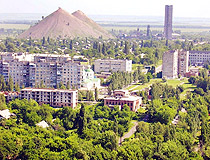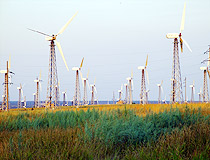Natural Wealth of Ukraine
Ukraine belongs to the leading mineral-raw countries of the world with a wide range of minerals. Ukraine - 0.4% of the Earth’s surface and 0.8% of the world’s population - has about 5% of the world’s mineral resources.
More than 20,000 deposits and manifestations of 200 different minerals have been discovered in Ukraine. Of these, 7,807 deposits of 94 types of minerals are of industrial importance. Ukraine holds one of the leading places in the reserves and extraction of iron, manganese, titanium-zirconium ores, non-metallic raw materials.
Coal, oil and natural gas, iron and manganese ores, native sulfur, rock and potassium salts, non-metallic building materials, mineral waters have the greatest economic importance. The deposits are located in different geological regions of Ukraine.
Main Natural Resources of Ukraine
Coal. Coal is the only hydrocarbon fossil raw material, which reserves can meet the needs of industry and energy in Ukraine in the next 200-500 years. Coal takes a leading place in the fuel and energy balance of Ukraine.
In the structure of hydrocarbon fossil resources of Ukraine, coal is about 95%, oil and gas - 2.5% each. The total coal reserves of Ukraine to a depth of 1,500 meters amount to about 117 billion tons. The main reserves of coal are concentrated in the Donetsk and Lviv-Volyn basins (94.9% of the total coal reserves of Ukraine: 92.4% in the Donetsk basin and 2.5% in the Lviv-Volynsky basin). More than 30% of the reserves of these basins are coking coal.
The Donetsk basin (Donbass), located on the territory of the Donetsk and Lugansk regions, is the largest in Ukraine. The discovered reserves of industrial categories of Donbass coal are 57 billion tons. With an annual production of 100 million tons, these reserves will last for 570 years.
The area of the basin is about 60,000 sq. km. (50,000 sq. km. within the Ukrainian border). The eastern part of the Donetsk basin is located in the Rostov region of Russia. Industrial coal mining began in 1795.
Donbass is the industrial heartland of Ukraine and one of the major industrial and mining-metallurgical complexes of Europe. It is the most urbanized and russified area of Ukraine. Kharkiv, Dnipro and Donetsk are the main cities.
The conditions for coal mining in the Donbass basin are complex: the depth - 1,200 meters, the thickness of the seams - 0.5-2.0 meters. This complicates the extraction of coal and determines its high cost. Coal mining in the Lviv-Volynsky basin is more favorable.
Oil and natural gas. In Ukraine there are about 138 million tons of oil, 1,118 billion cubic meters of natural gas, 79,483 thousand tons of gas condensate. Most of the available oil and gas fields have been in operation for decades and are mostly exhausted.
There are three main oil and gas bearing provinces in Ukraine. The main one is the Dnieper-Donetsk oil and gas province discovered in the 1950s. Oil deposits lie mainly at the depth of about 4,500 meters, gas and gas condensate - 5,000-6,000 meters.
The Carpathian oil province is located in the Ukrainian Carpathians and Transcarpathia. The Black Sea-Crimean oil and gas province occupies the Black Sea depression with the Crimean peninsula, the Black and Azov seas.
Oil shale reserves (3.7 billion tons) have been discovered at the border of the Kirovohrad and Cherkasy regions.
There are more than 2,500 peat deposits (2.2 billion tons). Peat deposits are located mainly in the Volyn, Rivne, Kyiv, Chernihiv, and Lviv regions.
Iron ore. Ukraine along with Russia and Australia has the largest iron ore reserves in the world, more than 10% of the world’s reserves in each country. The total reserves of iron ore in Ukraine are estimated at 27.4 billion tons.
60 out of 88 deposits are located in the Kryvyi Rih basin, with reserves of 18.7 billion tons. Iron ore reserves in the Kremenchuk basin are 4.5 billion tons, and in the Belozersky iron ore district (Zaporozhye region) - 2.5 billion tons. A significant part of the deposits of iron ore is developed by surface mining.
Manganese. Ukraine has the largest reserves of manganese ores in Europe and the second largest in the world (after South Africa). The main reserves (about 2.28 billion tons) are concentrated in the south of Ukraine: the Nikopol manganese basin in the Dnipropetrovsk and Zaporozhye regions (33% of the explored reserves of the country) and the Veliko-Tokmakskoye field in the Zaporozhye region (67%).
The total copper reserves are about 25 million tons.
Titanium. Ukraine has the largest reserves of titanium in Europe. 15 titanium deposits have been discovered in the country (4 of which are being developed). The deposits are located in the Kyiv, Dnipropetrovsk, Kharkiv, and Donetsk regions.
Uranium. The total confirmed uranium reserves are also the largest in Europe. The deposits of Russia exceed the Ukrainian ones, but their are located not in the European part of the Eurasian continent. Ukraine has 1.8% of world uranium reserves, 45.6 thousand tons. There are 17 deposits (14 in the Kirovohrad region, 2 in the Nikolaev region, 1 in the Dnipropetrovsk region).
Mercury. The total mercury reserves (1.9% of the world, 29,000 tons), Ukraine ranks 5th (after Spain, Algeria, China, and Kyrgyzstan).
In Ukraine, the total gold reserves are 3,200 tons.
Graphite. Ukraine holds the second place in the world in terms of graphite reserves (about 300 deposits with more than 1 billion tons, 20% of the world reserves, China - 26%).
Large reserves of potash salts are concentrated in the Ivano-Frankivsk and Lviv regions. The Ukrainian reserves of native sulfur are the largest among the countries of the former USSR.
The reserves of such building materials as limestones, chalk, marl, gypsum, clays are large and diverse. They are distributed throughout the country. Kaolin deposits are widely used in the porcelain and faience industry.
Ukraine has very large reserves of building stone, including the most high-quality facing stone (granites of the Zhytomyr, Vinnitsa, and other regions, marbles and tuffs of the Crimea and Transcarpathia).
So far, the presence of precious and ornamental stones has not been sufficiently studied, however, prospective areas of various gems are concentrated in Volyn (topaz); industrial reserves of high-quality amber are located near the village of Klesiv in the Rivne region, rhodonite - in the Carpathians; beryl, opal, amethyst, smoky quartz, rock crystal, jasper, etc are discovered.
Ukraine occupies a leading place in Europe in reserves of hydromineral resources. Territorially they are distributed extremely unevenly. The main part (about 70%) is concentrated in the northern and western regions. In total, about 200 deposits of mineral waters of all types have been discovered. Deposits of thermal waters are discovered in Transcarpathia and Crimea at the depth of 600-3,000 meters, the water temperature ranges from 40-80 to 110 degrees Celsius.
Hydropower resources of Ukraine make up about 44.7 billion kWh per year (theoretical gross hydropower potential), with 16 billion kWh being economically efficient (61% in the Dnipro River basin).



